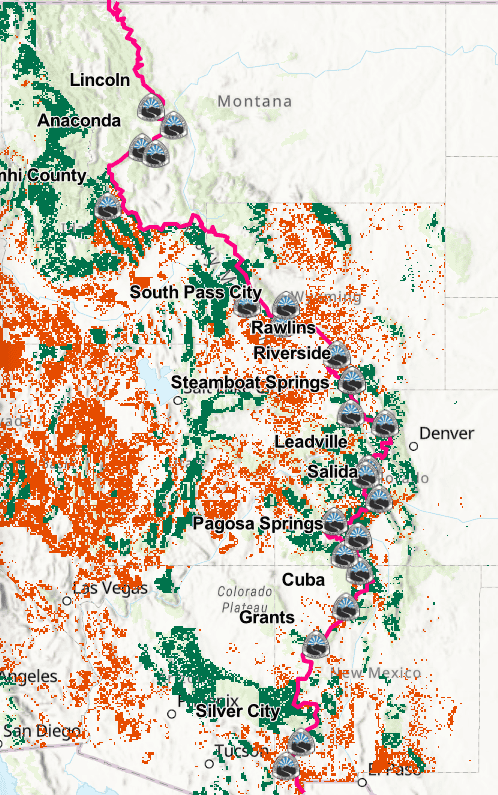With lots going on in Washington, D.C. right now, it can be hard to keep track of everything that could impact the Continental Divide Trail (CDT) and public lands. Let’s break down a few of the bills that we’re tracking right now:
The Federal Budget Reconciliation Process
As part of the federal budgeting process, each committee in the House and the Senate releases a budget reconciliation bill, which includes proposed budget provisions within its area of focus. (The committees whose bills typically have the biggest direct impact on public lands are the House Natural Resources Committee and the Senate Energy and Natural Resources Committee.) Then, all of the committees in a respective chamber combine their bills into an overall package, negotiate changes, and take a vote. If there are differences between the bills passed in the House and the Senate, the two chambers negotiate to combine the bills, because the two chambers must eventually both pass the same budget bill.
House of Representatives
The House of Representatives passed a budget reconciliation bill in May. Several provisions in the bill could have detrimental impacts on public lands, but perhaps the most striking is a provision that would allow oil and gas companies to pay to speed-up environmental analysis on their projects and exempt them from judicial review. This provision would allow companies to pay their way out of participating in fundamental environmental protection processes, reducing communities’ abilities to have a say in how nearby public lands are managed. Environmental review processes for energy projects on public lands near the CDT are essential to sound management of the trail – not to make it so that such projects cannot take place, but to ensure that they mitigate impacts to the trail and account for local community uses of the land. By undermining these processes, this provision limits CDTC’s and communities’ ability to speak on behalf of the CDT.
The House Natural Resources Committee’s budget reconciliation bill initially included a provision to sell over 400,000 acres of public lands in Nevada and Utah. After heated debate, this provision was removed from the bill. This is due, in part, to leadership from Republican Representatives from Continental Divide states, including Representative Ryan Zinke (MT), Troy Downing (MT), and Mike Simpson (ID), who spoke out in strong opposition to the sale of public lands. CDTC applauds these elected officials for taking a stance in support of the public lands that are beloved by and essential to the livelihoods of their constituents.
Valid methods of selling, leasing, exchanging, and transferring federal public lands in order to benefit the public already exist under the Federal Land Policy and Management Act, the Recreation and Public Purposes Act, and other laws. These methods aim to ensure that changes in ownership or management of public lands take place on a case-by-case basis to benefit the surrounding community. Attempts to dispose of large swaths of public lands through other legislation disregard the critical processes that these bills establish.
Senate
The Senate Energy and Natural Resources Committee recently released a budget reconciliation bill that includes many provisions with the potential to impact public lands along the CDT and across the country.
The provision that has drawn the most public attention in recent weeks is a section of the bill that would require the US Forest Service and Bureau of Land Management to sell at least two million acres of public lands in eleven western states, including New Mexico, Colorado, Idaho, and Wyoming. The bill states that the sale of public lands should be to address housing shortages in communities across the West, but the bill does not include sufficient guidance to ensure that land sales lead to the development of affordable, long-term, community-driven housing solutions.
While the physical tread of the CDT would not be eligible for sale, locations as close as 1,000 feet could be sold and developed, fundamentally changing the pristine scenery of the trail. Side and connecting trails to the CDT that are essential for community access, thru-hiker resupply, maintenance, and emergency response could also be sold. Nationally, this bill sets a dangerous precedent for allowing the federal government to dispose of the places that Americans hike, hunt, fish, and camp with limited input from the public.
The 2025 Conservation in the West poll found that less than a quarter of voters across the West think that selling public lands to develop housing is the best approach to addressing housing shortages.
The bill would also make it easier and cheaper for developers to lease public lands for oil and gas extraction, increase timber production in National Forests, and revoke congressionally- appropriated funds dedicated to hiring National Park Service employees.
Widespread public feedback contributed to the House of Representatives removing the sale of public lands from their budget reconciliation package. Now it’s time to direct that energy to the Senate! Call, email, or send mail to your elected officials today letting them know why public lands are valuable to you and your community.
More Legislation that affects the CDT
CDT Completion Act
Although the Continental Divide Trail was designated nearly 50 years ago, approximately 160 miles of “gap areas” along the CDT are still routed on busy roadways and highways. Introduced in April by Senators Martin Heinrich (D-NM) and Steve Daines (R-MT) and Representatives Joe Neguse (D-CO) and Teresa Leger Fernandez (D-CO), the Continental Divide Trail Completion Act (H.R.2877/ S.1470) would direct the Secretaries of Agriculture and the Interior to complete the CDT within ten years of the bill’s enactment. The CDT Completion Act does not directly acquire any land or authorize any government spending, and the bill states that eminent domain will never be used to complete the CDT. Think of the CDT Completion Act as requesting for the US Forest Service and the Department of the Interior to move completion of the CDT up on their to-do list!
Visit our CDT Action Center to add yourself to the list of CDT Completion Act supporters!
America the Beautiful Act
In May, Montana Senator Steve Daines introduced the America the Beautiful Act (S.1547). Now co-sponsored by a bipartisan group of seven Senators, including Senators Tim Sheehy (R-MT) and John Hickenlooper (D-CO), this bill would build on the historic investment in public lands made in the Great American Outdoors Act by extending the Legacy Restoration Fund for an additional eight years (through 2033) and increasing authorization to $2 billion per year. The Legacy Restoration Fund directs revenues from energy projects towards overdue maintenance projects on public lands, and every National Park that the CDT passes through has already benefitted from these funds. The America the Beautiful Act would represent a $16 billion investment in safer campgrounds, more accessible visitors centers, more enjoyable trails, and an overall improved experience for visitors to American public lands. Learn more about the America the Beautiful Act.
These bills are only a small portion of the many pieces of active legislation that could impact Americans’ access to hike, camp, hunt, fish, and spend time connecting to our public lands.
We also can’t overlook state-level successes for trails, outdoor access, and public lands that took place in state legislatures along the CDT this year! Check out our recent blog post to learn more: Celebrating Successes of 2025 State Legislative Sessions


